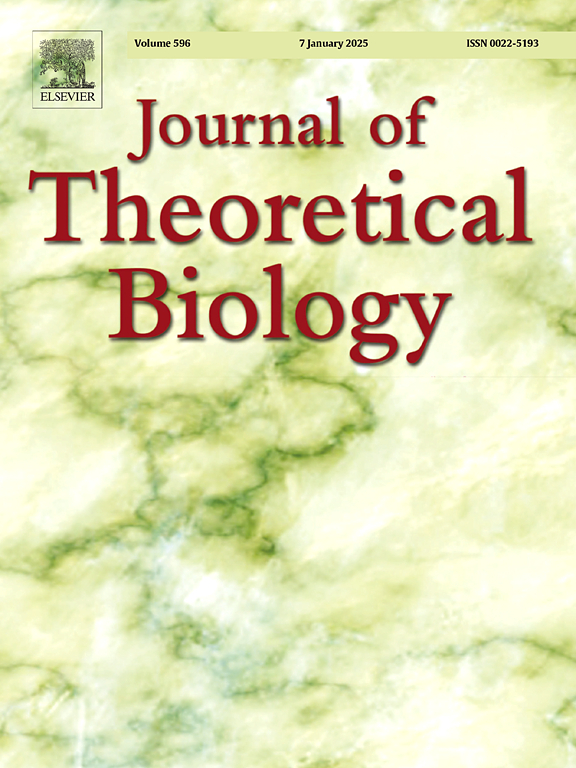A spatially resolved and lipid-structured model for macrophage populations in early human atherosclerotic lesions
IF 2
4区 数学
Q2 BIOLOGY
引用次数: 0
Abstract
Atherosclerosis is a chronic inflammatory disease of the artery wall. The early stages of atherosclerosis are driven by interactions between lipids and monocyte-derived-macrophages (MDMs). The mechanisms that govern the spatial distribution of lipids and MDMs in the lesion remain poorly understood. In this paper, we develop a spatially-resolved and lipid-structured model for early atherosclerosis. The model development and analysis are guided by images of human coronary lesions by Nakashima et al. (2007). Consistent with their findings, the model predicts that lipid initially accumulates deep in the intima due to a spatially non-uniform LDL retention capacity. The model also qualitatively reproduces the global internal maxima in the Nakashima images only when the MDM mobility is sufficiently sensitive to lipid content, and MDM lifespan sufficiently insensitive. Introducing lipid content-dependence to MDM mobility and mean lifespan produced minimal impact on model behaviour at early times, but strongly impacted lesion composition at steady state. Increases to the sensitivity of MDM lifespan to lipid content yield lesions with fewer MDMs, less total lesion lipid content and reduced mean MDM infiltration depth. Increases to the sensitivity of MDM mobility to lipid content also reduces the MDM infiltration depth, but increases the proportion of lipid-laden MDMs. We find that MDM lipid content increases with spatial depth, regardless of blood LDL and HDL content. These results shed light on the mechanisms that drive spatial variation in the composition of early atherosclerotic lesions, and the role of macrophage lipid content in disease progression.
早期人类动脉粥样硬化病变中巨噬细胞群体的空间分解和脂质结构模型。
动脉粥样硬化是动脉壁的慢性炎症性疾病。动脉粥样硬化的早期阶段是由脂质和单核细胞衍生巨噬细胞(MDMs)之间的相互作用驱动的。控制脂质和MDMs在病变中的空间分布的机制仍然知之甚少。在本文中,我们开发了一个空间分辨和脂质结构的早期动脉粥样硬化模型。模型的开发和分析以Nakashima等人的人类冠状动脉病变图像为指导。Nakashima等人(2007)。与他们的发现一致,该模型预测,由于LDL在空间上的保留能力不均匀,脂质最初在内膜深处积聚。只有当MDM迁移率对脂质含量足够敏感,而MDM寿命足够不敏感时,该模型才定性地再现Nakashima图像中的全局内部最大值。将脂质含量依赖性引入MDM迁移率和平均寿命,在早期对模型行为的影响很小,但在稳态时对病变组成的影响很大。随着MDM寿命对脂质含量敏感性的增加,MDM数量减少、总脂质含量减少、平均MDM浸润深度降低的病变也会发生变化。MDM迁移率对脂质含量敏感性的提高也降低了MDM的浸润深度,但增加了脂质负载MDM的比例。我们发现MDM脂质含量随空间深度增加,与血液LDL和HDL含量无关。这些结果揭示了驱动早期动脉粥样硬化病变组成空间变化的机制,以及巨噬细胞脂质含量在疾病进展中的作用。
本文章由计算机程序翻译,如有差异,请以英文原文为准。
求助全文
约1分钟内获得全文
求助全文
来源期刊
CiteScore
4.20
自引率
5.00%
发文量
218
审稿时长
51 days
期刊介绍:
The Journal of Theoretical Biology is the leading forum for theoretical perspectives that give insight into biological processes. It covers a very wide range of topics and is of interest to biologists in many areas of research, including:
• Brain and Neuroscience
• Cancer Growth and Treatment
• Cell Biology
• Developmental Biology
• Ecology
• Evolution
• Immunology,
• Infectious and non-infectious Diseases,
• Mathematical, Computational, Biophysical and Statistical Modeling
• Microbiology, Molecular Biology, and Biochemistry
• Networks and Complex Systems
• Physiology
• Pharmacodynamics
• Animal Behavior and Game Theory
Acceptable papers are those that bear significant importance on the biology per se being presented, and not on the mathematical analysis. Papers that include some data or experimental material bearing on theory will be considered, including those that contain comparative study, statistical data analysis, mathematical proof, computer simulations, experiments, field observations, or even philosophical arguments, which are all methods to support or reject theoretical ideas. However, there should be a concerted effort to make papers intelligible to biologists in the chosen field.

 求助内容:
求助内容: 应助结果提醒方式:
应助结果提醒方式:


